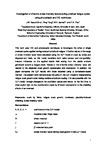Investigation of effective stress intensity factors during overload fatigue cycles using photoelastic and DIC techniques
| dc.contributor.author | Vasco-Olmo, JM | en |
| dc.contributor.author | Yang, B | en |
| dc.contributor.author | James, MN | en |
| dc.contributor.author | Díaz, FA | en |
| dc.date.accessioned | 2018-09-10T11:56:52Z | |
| dc.date.available | 2018-09-10T11:56:52Z | |
| dc.date.issued | 2018-10 | en |
| dc.identifier.issn | 0167-8442 | en |
| dc.identifier.uri | http://hdl.handle.net/10026.1/12313 | |
| dc.description.abstract |
© 2018 Elsevier Ltd This work uses DIC and photoelastic techniques to investigate the effect of single overload cycles applied during constant amplitude fatigue. Effective values of the range of stress intensity factor were calculated using the CJP model of crack tip stress and displacement fields, as this model considers both wake contact and compatibility-induced influences on the applied elastic field arising from the plastic enclave generated around a fatigue crack. Values of the effective stress intensity factor are related to the observed crack growth acceleration and retardation. In addition, the paper compares the CJP results with those obtained using a compliance-based method. The present work demonstrates the utility of the CJP model in characterising fatigue crack growth rates during variable amplitude loading. It is also possible with the CJP model, through changes in the coefficient values and hence, for the first time, to shed explicit light on the contributions made by different mechanisms to the shielding effects of an overload. | en |
| dc.format.extent | 73 - 86 | en |
| dc.language.iso | en | en |
| dc.publisher | Elsevier | en |
| dc.title | Investigation of effective stress intensity factors during overload fatigue cycles using photoelastic and DIC techniques | en |
| dc.type | Journal Article | |
| plymouth.volume | 97 | en |
| plymouth.journal | Theoretical and Applied Fracture Mechanics | en |
| dc.identifier.doi | 10.1016/j.tafmec.2018.07.011 | en |
| plymouth.organisational-group | /Plymouth | |
| plymouth.organisational-group | /Plymouth/Faculty of Science and Engineering | |
| plymouth.organisational-group | /Plymouth/Faculty of Science and Engineering/School of Engineering, Computing and Mathematics | |
| plymouth.organisational-group | /Plymouth/Users by role | |
| plymouth.organisational-group | /Plymouth/Users by role/Academics | |
| dcterms.dateAccepted | 2018-07-31 | en |
| dc.rights.embargodate | 2019-08-01 | en |
| dc.rights.embargoperiod | Not known | en |
| rioxxterms.versionofrecord | 10.1016/j.tafmec.2018.07.011 | en |
| rioxxterms.licenseref.uri | http://www.rioxx.net/licenses/all-rights-reserved | en |
| rioxxterms.licenseref.startdate | 2018-10 | en |
| rioxxterms.type | Journal Article/Review | en |


